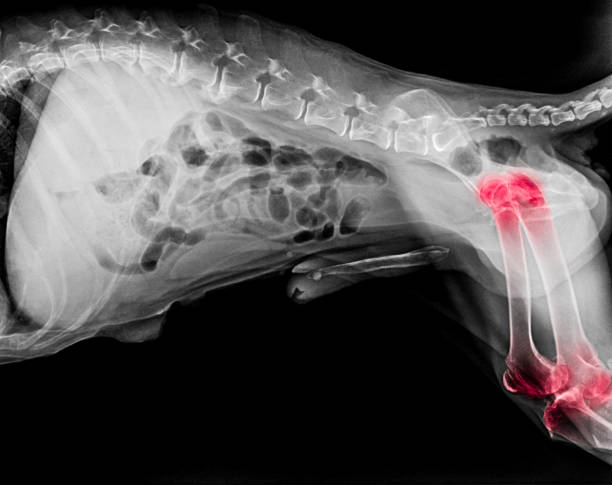Hip Dysplasia In Dogs: Causes, Symptoms, Diagnosis, Treatment
The specter of hip dysplasia may send shivers through the hearts of those with large- and giant-breed dogs, yet the reality is that this painful condition knows no size or breed boundaries.
Regardless of your canine companion’s dimensions, hip dysplasia can cast a shadow over their quality of life, presenting a challenging ordeal for pet owners.
The silver lining lies in the realm of responsible dog ownership and knowledge about potential health issues like hip dysplasia.
Empowering yourself with information about symptoms, treatment options, and preventative measures can significantly contribute to ensuring your dog’s comfort and maintaining their overall well-being.
What is hip dysplasia in dogs?
Hip dysplasia in dogs is a musculoskeletal issue marked by an irregular hip joint formation, affecting dogs of all sizes, though more prevalent in larger breeds. This condition leads to joint instability, wear, and tear, potentially progressing to arthritis.
Dogs with hip dysplasia experience discomfort, pain, and reduced mobility, displaying symptoms like lameness, difficulty rising, reluctance with stairs, and a swaying gait. While often hereditary, factors like rapid growth and poor nutrition contribute.
Though incurable, management options enhance the dog’s quality of life, including weight control, physical therapy, anti-inflammatory medications, and, in severe cases, surgery.
Regular veterinary check-ups, especially for susceptible breeds, aid in early detection and proactive care. Recognizing signs, risk factors, and available interventions is vital for pet owners ensuring optimal support for dogs with hip dysplasia.
causes of hip dysplasia in dogs
Hip dysplasia in dogs has multifaceted causes, often involving a combination of genetic and environmental factors.
Genetic Predisposition:
Genetic inheritance plays a significant role, with certain breeds being more susceptible to hip dysplasia. Breeds such as German Shepherds, Labrador Retrievers, and Golden Retrievers are commonly affected due to a hereditary predisposition.
Improper Development:
Rapid growth during puppyhood, especially in large and giant breeds, can contribute to hip dysplasia. Improper bone and joint development may occur when a dog grows too quickly, leading to an ill-fitted hip joint.
Nutritional Factors:
Inadequate nutrition, particularly in terms of excessive or deficient dietary components, can impact skeletal development and contribute to the development of hip dysplasia.
Excessive Exercise at a Young Age:
Intense or excessive physical activity during a dog’s early developmental stages may increase the risk of hip dysplasia, as the joints may not have properly formed to withstand such stress.
Joint Instability:
Abnormal joint structure or laxity in the hip joint can lead to instability. When the joint doesn’t fit together correctly, it can result in wear and tear, ultimately contributing to hip dysplasia.
Understanding these causes is crucial for both breeders and pet owners, as it allows for informed breeding practices, responsible puppy rearing, and preventive measures to minimize the risk of hip dysplasia in susceptible dogs. Regular veterinary check-ups and adherence to proper nutrition and exercise regimens play essential roles in managing and preventing this orthopedic condition.
Glucosamine for Canine Arthritis
As a supplement to promote joint health and manage ailments like arthritis, glucosamine for dogs with joint illness has grown in popularity. The natural substance glucosamine is essential to the production and maintenance of cartilage, which protects and cushions joints.
Joint Support:
Glucosamine supplements are often used to provide additional support to dogs experiencing joint diseases such as osteoarthritis. The compound is believed to aid in maintaining the structural integrity of joints and slow down the progression of joint degeneration.
Cartilage Repair:
As dogs age or face joint-related issues, their natural production of glucosamine may decrease. Supplementing with glucosamine is thought to contribute to the repair of damaged cartilage, potentially reducing pain and stiffness associated with joint diseases.
Anti-Inflammatory Properties:
Glucosamine is also recognized for its anti-inflammatory properties, which can be beneficial in alleviating inflammation in the joints. This can result in improved mobility and overall joint function for dogs dealing with arthritis or other joint disorders.
Chondroitin Synergy:
Glucosamine supplements often include chondroitin, another compound crucial for cartilage health. The combination of glucosamine and chondroitin is believed to provide a synergistic effect, enhancing their joint-protective benefits.
Considerations and Consultation:
While glucosamine is generally considered safe for dogs, it’s essential to consult with a veterinarian before introducing any supplements. The appropriate dosage varies based on the dog’s size, health condition, and other factors.
In summary, glucosamine supplements can be a valuable addition to the management of joint diseases in dogs. However, professional guidance is crucial to ensure the proper use and dosage tailored to the individual needs of the dog.
Symptoms of Hip Dysplasia in Dogs

The symptoms of hip dysplasia in dogs can manifest in various ways, indicating discomfort and potential joint issues. Common signs to be aware of include:
Lameness:
Dogs with hip dysplasia may exhibit lameness or an uneven gait, especially noticeable when walking or running.
Difficulty Rising:
Affected dogs may struggle to rise from a sitting or lying position, showing reluctance to put weight on their hind limbs.
Stiffness and Discomfort:
Dogs with hip dysplasia may display stiffness, particularly after periods of rest, and they may exhibit signs of discomfort when moving.
Decreased Activity Levels:
A reduction in overall activity levels can be a sign of hip dysplasia, as dogs may avoid physical activities that exacerbate their discomfort.
Bunny Hopping:
Some dogs with hip dysplasia may adopt a “bunny hopping” gait, where both hind legs move together simultaneously, reducing strain on the affected hip joints.
Reluctance to Climb Stairs or Jump:
Dogs experiencing hip dysplasia may be hesitant or unwilling to climb stairs, jump onto furniture, or engage in activities that require significant hind limb effort.
Audible Signs of Pain:
Whining, whimpering, or vocalizing during movement can indicate pain associated with hip dysplasia.
It’s important to note that these symptoms may vary in intensity, and some dogs may show subtle signs early on. Prompt veterinary evaluation is crucial if hip dysplasia is suspected, as early detection allows for proactive management strategies to improve the dog’s quality of life. Regular check-ups, especially for breeds prone to hip dysplasia, aid in monitoring and addressing potential joint issues.
Diagnosing Hip Dysplasia in Dogs
Diagnosing hip dysplasia in dogs involves a comprehensive approach, typically initiated when pet owners observe signs of discomfort or altered mobility in their canine companions. Veterinary professionals employ the following methods to diagnose hip dysplasia:
Clinical Examination:
A thorough physical examination is conducted to assess the dog’s gait, posture, and range of motion in the hip joints. The veterinarian looks for signs of pain, discomfort, or abnormalities in movement.
Palpation:
Manual palpation of the hip joints helps identify any irregularities, pain, or instability. Discomfort or a clicking sensation during manipulation may raise suspicion of hip dysplasia.
X-rays (Radiography):
X-rays are a key diagnostic tool for confirming hip dysplasia. They provide detailed images of the hip joints, revealing the degree of joint laxity, bone abnormalities, and the presence of arthritis. Sedation or anesthesia may be necessary to obtain accurate positioning during the procedure.

Additional Imaging:
In some cases, additional imaging techniques such as computed tomography (CT) or magnetic resonance imaging (MRI) may be recommended for a more in-depth evaluation of the hip joint structures.
Genetic Testing:
While not a direct diagnostic tool, genetic testing can help identify breeds predisposed to hip dysplasia. This information, combined with clinical findings, aids in early detection and preventive measures.
After a diagnosis, hip dysplasia severity is classified, which helps create a customized treatment strategy. Management options may include lifestyle modifications, weight control, physical therapy, anti-inflammatory medications, and, in severe cases, surgical intervention.
Early detection and intervention are crucial for minimizing pain and improving the overall quality of life for dogs with hip dysplasia. Regular veterinary check-ups, especially for breeds prone to this condition, contribute to proactive monitoring and timely management.
Treating Hip Dysplasia in Dogs
Treating hip dysplasia in dogs involves a multifaceted approach aimed at alleviating pain, improving mobility, and enhancing the overall quality of life for the affected animal. The specific treatment plan may vary based on the severity of the condition, but common strategies include:
Weight Management:
Maintaining an optimal body weight is crucial for dogs with hip dysplasia. Excess weight puts additional strain on the joints, exacerbating symptoms. A tailored diet and regular exercise help manage weight and reduce stress on the hip joints.
Physical Therapy:
Therapeutic exercises and physical therapy can strengthen supporting muscles, improve joint stability, and enhance the dog’s range of motion. Controlled, low-impact activities are often recommended to avoid excessive stress on the hips.
Anti-Inflammatory Medications:
Non-steroidal anti-inflammatory drugs (NSAIDs) may be prescribed to reduce inflammation and alleviate pain associated with hip dysplasia. Veterinarians carefully monitor the use of these medications to manage potential side effects.
Joint Supplements:
Glucosamine and chondroitin supplements are commonly recommended to support joint health and cartilage repair. These supplements aim to slow the progression of hip dysplasia and improve joint function.
Pain Management:
Pain relief is a crucial aspect of hip dysplasia treatment. Veterinarians may prescribe pain medications or alternative therapies, such as acupuncture, to help manage discomfort and improve the dog’s well-being.
Surgical Intervention:
In severe cases or when conservative measures are insufficient, surgical options may be considered. Procedures like hip replacement or femoral head ostectomy aim to improve joint function and reduce pain.
Lifestyle Modifications:
Adjustments to the dog’s living environment, such as providing orthopedic bedding or ramps to minimize jumping, can contribute to a more comfortable lifestyle for a dog with hip dysplasia.
Regular veterinary check-ups are essential to monitor the dog’s progress and make necessary adjustments to the treatment plan. Early intervention and consistent management strategies can significantly enhance the quality of life for dogs coping with hip dysplasia.
Preventing Hip Dysplasia in Dogs
Preventing hip dysplasia in dogs involves proactive measures aimed at reducing risk factors and promoting overall joint health. Consider the following strategies to help prevent the development or progression of hip dysplasia:
Breed Selection:
When choosing a dog, research and select breeds with lower predisposition to hip dysplasia. Responsible breeding practices and obtaining puppies from reputable breeders who prioritize health can minimize genetic risks.
Balanced Nutrition:
Ensure your dog receives a balanced and appropriate diet, especially during the crucial growth stages. Proper nutrition supports healthy bone and joint development, reducing the risk of musculoskeletal issues like hip dysplasia.
Weight Management:
Maintain your dog at a healthy weight to reduce stress on the hip joints. Excess weight can contribute to the development and exacerbation of hip dysplasia, so regular exercise and portion control are essential.
Regular Exercise:
Provide controlled and moderate exercise to strengthen muscles and maintain joint flexibility. Avoid high-impact activities, especially for puppies, to protect developing joints.
Supplements:
Consider joint supplements like glucosamine and chondroitin to support joint health. Consult with your veterinarian to determine the appropriate dosage and type of supplements for your dog’s specific needs.
Environmental Modifications:
Create a joint-friendly environment by using orthopedic bedding and minimizing the need for jumping, especially for breeds prone to hip dysplasia. Provide ramps or steps to assist with climbing onto furniture or into vehicles.
Routine Veterinary Check-ups:
Schedule regular check-ups with your veterinarian, particularly for breeds susceptible to hip dysplasia. Early detection allows for timely intervention and management strategies if any signs of joint issues arise.
Genetic Testing:
If considering breeding, opt for genetic testing to identify dogs with a lower risk of passing on hip dysplasia. This helps in making informed breeding decisions to reduce the prevalence of the condition.
By combining these preventive measures, dog owners can significantly contribute to minimizing the risk of hip dysplasia and promoting the long-term joint health and well-being of their canine companions.
See also: Dog Heimlich
Frequently Asked Queastions
In no way should hip dysplasia decrease your dog’s life. Any dog with the illness should be able to spend a full and active life as long as it receives therapy and is adequately cared for at home.
Problems only arise when the dog overeats or is too uncomfortable to exercise to maintain a healthy weight.
Be sure to proceed cautiously. To avoid straining your muscles, it’s also crucial to warm up and cool down.
It should just take five to ten minutes to walk flat. Maintaining your pet’s extremely slender body condition is crucial to reducing the overall pressure on the hips.
The most common clinical indications are weakness and discomfort in the rear legs. The dog is hesitant to get up from a sitting or reclining posture and seems unsteady. Certain dogs may limp or show reluctance while climbing stairs.
While some months old pups may exhibit these symptoms, dogs between the ages of one and two years old are more likely to do so.
Conclusion
Understanding hip dysplasia in dogs is crucial for responsible ownership. Regardless of size or breed, it can affect a dog’s quality of life.
Recognizing signs, knowing causes, and exploring treatments, including joint supplements like glucosamine, empowers pet owners.
Regular vet check-ups aid in early detection, and preventive measures, such as balanced nutrition and exercise, minimize the risk.
This holistic approach ensures informed decisions, contributing to the well-being of dogs and working towards a future with effective management and prevention of hip dysplasia.






